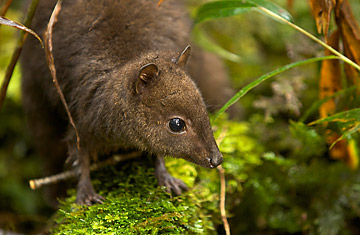
The world's smallest known wallaby, Dorcopsulus sp. nov., is seen in this handout photo released May 17, 2010
Even after 4 billion years, nature never runs out of new product lines. Just when you think you've seen the biggest or the smallest or the strangest possible organism, something even more intriguing turns up. In the world of living things, it's always a new model year.
Nature's remarkable — and even whimsical — diversity is on display once again with the release of the results of a 2008 expedition to the Foja Mountains in New Guinea. Among the critters uncovered in a part of the wild colloquially known as the Lost World is a new species of dwarf wallaby, a large (and oddly friendly) woolly rat, a pair of new imperial pigeons and a tree frog with an inflatable nose (really).
The expedition — which lasted four weeks, ranged from the foothills of the mountains to peaks 7,200 ft. (2,200 m) high and went on despite regular flooding that nearly washed the investigators' camp away — was led by Conservation International as part of its Rapid Assessment Program (RAP). Developed in 1990, RAP is the unlikely brainchild of Nobel Prize–winning physicist Murray Gell-Mann, who, along with the late ornithologist Ted Parker, realized that what conservationists really needed was a sort of biological SWAT team that could sweep into a wilderness area and take a fast, thorough census of its wildlife so that policymakers could have the information they need to protect new and endangered species.
"Gell-Mann and Parker were sitting around a campfire in South America and came up with the idea," says ornithologist Bruce Beehler, who participated in the Foja expedition. "Within a year, a group of cutting-edge field scientists were testing rapid survey methods in the Andes. It was rough and ready and addressed a pressing need to know what's out there in the world's richest forests."
Richness is a word that certainly describes Foja. Over the course of millions of years, the Australian continental plate crept northward, plowing up sea floor and causing it to compress into the New Guinea land mass. As the mountains slowly rose, the higher altitudes remained in a sort of permanent springtime — misty, cool and stable — while the areas below grew much hotter. Animals that adapted to the cooler surroundings were thus stuck on the mountains, unable to descend into the warmer, more hostile environment below.
"The Foja Range is a poster child for Darwin's theory," says Beehler, "combining isolation with novel habitat and adding a bit of time — at least a million years."
As Darwin knew, that's a recipe for all kinds of interesting life forms. The tree frog discovered by the expedition measures just under 2 in. (5 cm) and has a short, faintly trunklike nose. When the male is calling, its nose inflates. When he loses interest in whatever he thought he spotted, it deflates and points downward. The dwarf wallaby, kin to the kangaroo but clearly from the pintsize part of the family, is no bigger than a small cat. The woolly rat — which weighs about 3.5 lb (1.6 kg) and measures 18 in. (46 cm) from nose to tail — would scare the daylights out of anyone who encountered it on a city street late at night, yet it is quite tame. The pigeons, common animals by most measures, have an elegant plumage that is a mix of pearl gray, rust and white.
"When the group came across the pigeons, the three field ornithologists spent a lot of time puzzling over what it was," says Beehler. Other species the team discovered included a new black-and-white butterfly related to the monarch, a new flowering shrub and a bent-toed gecko with a face like a gargoyle.
What the expedition says about the biological exuberance of the Foja Mountains is almost secondary to what it says about the promise of the RAP concept. Federal and state agencies have developed similar programs, including the National Oceanic and Atmospheric Administration, which has a RAP team for oil spills and other toxic events. Conservation International itself has partnered with the Field Museum in Chicago in a program called AquaRAP to assess freshwater ecosystems in Latin America. If life has proved one thing over the eons, it's that it can flourish almost anywhere. It's always easier to argue for conservation when we know what we're conserving and just where it lives.
